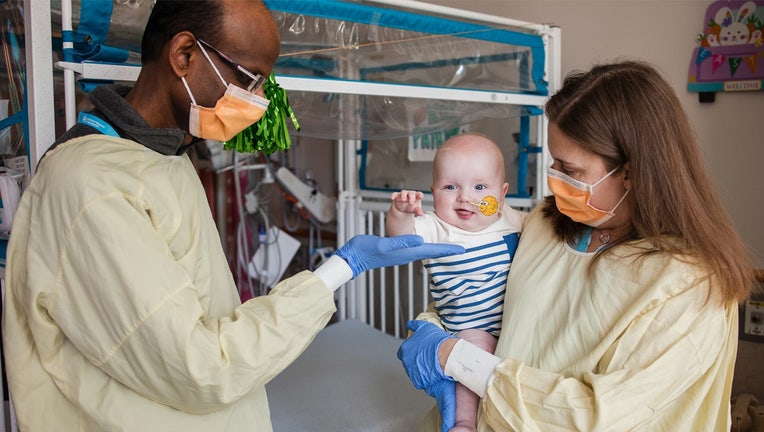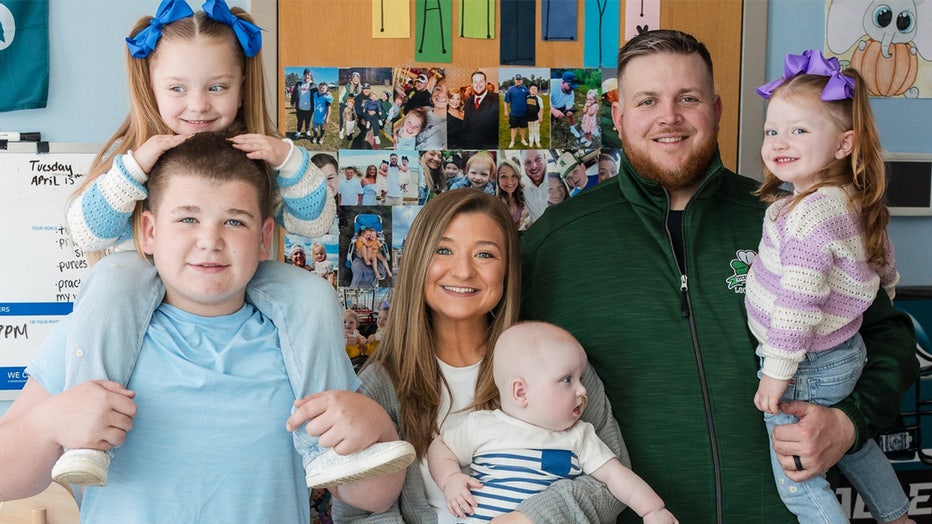Baby born with rare disorder thrives after getting personalized gene editing treatment

FILE - Kiran Musunru, MD, PhD, MPH, ML, MRA, (left) and Rebecca Ahrens-Nicklas, MD, PhD, (right) led the group of researchers from CHOP and Penn who developed a personalized treatment for baby KJ. (Children’s Hospital of Philadelphia [CHOP])
A baby born with a rare and dangerous genetic disease is thriving after receiving an experimental gene editing treatment that was made just for him.
In a study published in the New England Journal of Medicine on Thursday, researchers said the baby’s case is among the first to be successfully treated with a custom therapy that seeks to fix a tiny but critical error in his genetic code.
KJ Muldoon of Clifton Heights, Pennsylvania, was diagnosed with severe CPS1 deficiency shortly after being born. Within six months, a team at Children’s Hospital of Philadelphia (CHOP) and Penn Medicine, as well as their partners, created a therapy specifically designed to correct KJ’s faulty gene through CRISPR.
What is severe CPS1 deficiency?
Dig deeper:
People diagnosed with severe CPS1 deficiency lack an enzyme that is needed to help remove ammonia from their bodies.
This deficiency then leads to a build up of ammonia in their blood and becomes toxic. A liver transplant is another option to treat this illness.
By the numbers:
About one in a million babies are diagnosed with this rare disease.

FILE - KJ was only days old when he was diagnosed with a rare metabolic disorder and transferred to Children's Hospital of Philadelphia where doctors were actively researching new cell and gene therapies. (Children’s Hospital of Philadelphia [CHOP])
What is CRISPR gene editing?
CRISPR is a gene editing tool that won its inventors the Nobel Prize in 2020.
Instead of cutting the DNA strand like the first CRISPR approaches, doctors employed a technique that flips the mutated DNA "letter" — also known as a base — to the correct type.
Known as "base editing," it reduces the risk of unintended genetic changes.
The backstory:
Gene therapies, which can be extremely expensive to develop, generally target more common disorders in part for simple financial reasons: more patients mean potentially more sales, which can help pay the development costs and generate more profit.
The first CRISPR therapy approved by the U.S. Food and Drug Administration, for example, treats sickle cell disease, a painful blood disorder affecting millions worldwide.
Dr. Kiran Musunuru, a University of Pennsylvania gene editing expert who co-authored the study about KJ’s treatment, said his team’s work — funded in part by the National Institutes of Health — showed that creating a custom treatment doesn’t have to be prohibitively expensive.
The cost was "not far off" from the $800,000-plus for an average liver transplant and related care, he said.
"As we get better and better at making these therapies and shorten the time frame even more, economies of scale will kick in and I would expect the costs to come down," Musunuru said.
KJ’s health journey

FILE - KJ's family is looking forward to welcoming him home. (Children’s Hospital of Philadelphia [CHOP])
Timeline:
In February, KJ got his first IV infusion with the gene editing therapy, delivered through tiny fatty droplets called lipid nanoparticles that are taken up by liver cells.
After follow-up doses in March and April, KJ has been able to eat more normally and has recovered well from illnesses like colds, which can strain the body and exacerbate symptoms of CPS1. The 9 ½-month-old also takes less medication.
Considering his poor prognosis earlier, "any time we see even the smallest milestone that he’s meeting – like a little wave or rolling over – that’s a big moment for us," his mother said.
What's next:
Despite the positive results, researchers caution that it’s only been a few months since KJ began receiving this new treatment. He’ll need to be under observation for years.
What they're saying:
"We’re still very much in the early stages of understanding what this medication may have done for KJ," Dr. Rebecca Ahrens-Nicklas, a gene therapy expert at CHOP, said. "But every day, he’s showing us signs that he’s growing and thriving."
The Source: Information for this article was taken from a Children's Hospital of Philadelphia news release and The Associated Press. This story was reported from Los Angeles.

